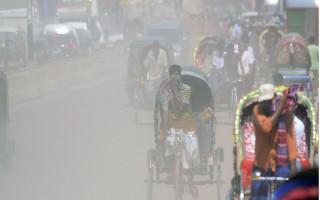City children affected by severe air pollution: UNICEF
Children in Bangladesh living in and near industrial or urban cities are the most vulnerable to hazardous diseases caused by outdoor and indoor air pollutions.
Density of particulate matters or dust in the air is increasing due to unplanned construction of building and road, repair of supply lines of utilities and brick kilns, leading to severe air pollution, environment and health experts have said.
Poor ventilation in house and traditional cooking practices also contribute to indoor air pollution.
A UNICEF report titled ‘Clean Air for Children’, published on Sunday, says that annually more than 8,500 children die in Bangladesh from diseases caused by indoor air pollution.
It also says that around 300 million children currently live in areas where outdoor air pollution exceeds international guidelines.
The annual limit of particulate matter in the air, set by the World Health Organisation, is 10 micron per cubic metre.
Ultrafine air pollutant, less than 2.5 microns in diameter, penetrates deep inside children’s lung and even enters into the bloodstream that causes heart disease and other cardiovascular complications.
Primarily produced from smoke and fumes, ultrafine could easily enter and irritate children’s lungs and damage their brain tissue.
The 2016 comparative risk assessment of the Global Burden of Disease 2015 found that air pollution exposure was linked to around 7 million deaths worldwide.
Of those, around 600,000 were children under five.
Air pollution causes severe threats to children as they breathe twice as quickly as adults.
According to the GBD 2015 report, air pollution-related cerebral and cardiovascular infections are the highest causes for premature death in Bangladesh.
The University of Washington-based Institute for Health Metrics and Evaluation prepares the GBD.
Mominul Islam, associate sub project manager of the Air Quality Research and Monitoring Centre at Dhaka University, have said that density of the hazardous outdoor pollutants is very high in the air of Dhaka, Chittagong, Khulna and Narayanganj cities.
The average PM level in Dhaka ranges between 87 to 170 micron per cubic metre, which is translated as moderate to unhealthy for children and asthma patients.
The UNICEF report, referring to several studies, has found that the household concentration of PM in Bangladesh ranges between 223 to 515 micron per cubic metre.
MD Shofiqul Alam, specialist at UNICEF Bangladesh, suggested use of improved cooking stove to reduce indoor air pollution.
News Courtesy: www.newagebd.net











